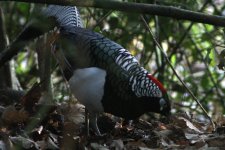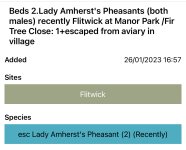The bird is at Manor Park, Flitwick. If you park somewhere along Church Road and walk down the A5120 towards Flitvale garden center, you will pass a gate right before a bridge over a small river and near the sign 'Flitwick Manor'. Enter the forest and take the first trail which goes right to walk through a narrow strip of forest running along the A5120. The pheasant has been seen along this area of wood, particularly the area near a wooden bridge towards the end of the forest.
Be warned that this bird is very shy and extremely difficult to see, I cannot emphasise that word enough. You will understand why when you get there. Rhododendrons are all over the place, and the thick understorey make it a worst-case scenario for a bird which is known to be extremely shy and difficult to observe in the wild. If you quietly keep to the path and walk back and forth along it whilst watching the bushes close to the road, you should find it eventually. It took me 1hr 30 mins to get the photo below. Some spent three hours looking and then only saw it, whereas others never saw it after hours of searching. This may be the last chance to see this bird in its "natural" range. I have a feeling when this bird goes, that's it for the UK.
Good luck.
View attachment 1490894









